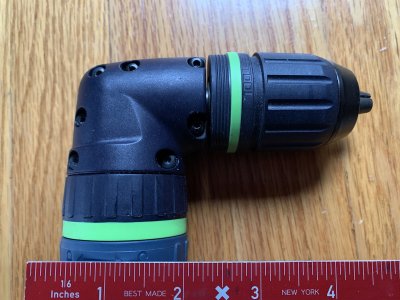JonathanJung
Member
- Joined
- Apr 7, 2018
- Messages
- 265
I’m always struggled for a better way to bore through framing, particularly when studs are closer together. I'm renovating a house and will be running wire and plumbing, so I’ll need to drill a lot of holes through studs, joists, etc. I’ve got WoodOwl Nail Chipper bits on the way. They have a 7/16” hex shank.
The Milwaukee M18 Hole Hawg looks good, at $218 reconditioned. But then I was thinking with a Festool drill with a right angle and a handle, I could eliminate a couple of my drills, and get something strong enough to handle stud boring. A few questions:
Will the Festool right angle adapters handle auger bits and hole saws?
Which Festool drills accept handles?
Will the Festool chuck on a right angle handle a 7/16” bit? I can’t find the capacity of the chuck.
With the Festool chuck attached to the right angle attached to the drill, what’s the overall length?
Here’s the drills I already have:
Milwaukee M18 Fuel Surge impact driver
Milwaukee M12 Fuel hammer drill
Milwaukee M18 Fuel drywall screw gun
Milwaukee M18 Fuel hammer drill
Milwaukee M12 Installation Drill
Milwaukee M12 2407 drill
Bosch GSR12V-140FCB22 5-in-1
Bosch GSR12V-300B22 drill
Any suggestions welcome. Am I barking up the wrong tree, thinking a Festool drill can handle the task, or should I just get a heavy duty right angle drill that’s designed for large bores in framing?
The Milwaukee M18 Hole Hawg looks good, at $218 reconditioned. But then I was thinking with a Festool drill with a right angle and a handle, I could eliminate a couple of my drills, and get something strong enough to handle stud boring. A few questions:
Will the Festool right angle adapters handle auger bits and hole saws?
Which Festool drills accept handles?
Will the Festool chuck on a right angle handle a 7/16” bit? I can’t find the capacity of the chuck.
With the Festool chuck attached to the right angle attached to the drill, what’s the overall length?
Here’s the drills I already have:
Milwaukee M18 Fuel Surge impact driver
Milwaukee M12 Fuel hammer drill
Milwaukee M18 Fuel drywall screw gun
Milwaukee M18 Fuel hammer drill
Milwaukee M12 Installation Drill
Milwaukee M12 2407 drill
Bosch GSR12V-140FCB22 5-in-1
Bosch GSR12V-300B22 drill
Any suggestions welcome. Am I barking up the wrong tree, thinking a Festool drill can handle the task, or should I just get a heavy duty right angle drill that’s designed for large bores in framing?



